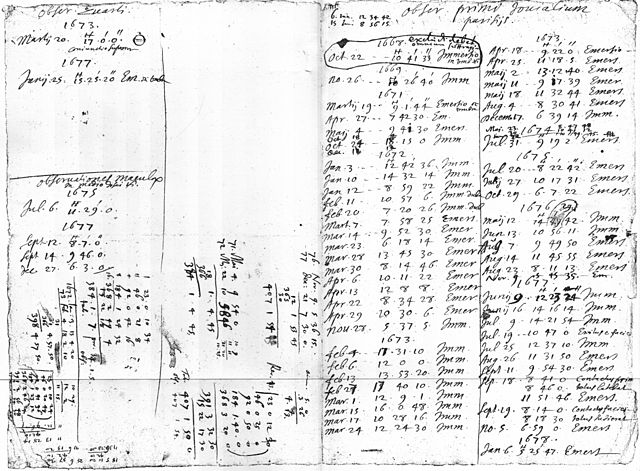Speaking of the timing of astronomical phenomena, as we were yesterday, the timing of celestial bodies was the key to the first demonstration of one of the pillars of modern physics, the fact that light travels at a finite speed. This actually pre-dates yesterday’s longitude discoveries, which I always forget, because it seems like it should’ve been a later development.
The first really convincing demonstration that light doesn’t cover arbitrary distances instantaneously dates from 1676, and was the work of the Danish astronomer Ole Rømer. Under the direction of Giovanni Cassini at the Paris Observatory, Rømer was making very careful measurements of the motion of the moons of Jupiter, in particular the innermost and fastest-moving of the big moons, Io.
Io was one of the four moons spotted by Galileo around 1610, so its motion had been tracked for decades by the time Rømer got to Paris and started studying it. Astronomers had a very good idea of its average orbital period from all those observations, and based on that average, could make a prediction of the exact time when Io should disappear behind Jupiter for a long time in the future. (This was proposed as another method of determining time in order to find longitude; however, making the necessary measurements from the deck of a moving ship was, shall we say, a significant technical challenge…)
Rømer noticed an odd aberration in his measurements, though. Over a very long period of time, the prediction of Io’s eclipses was pretty good, but for shorter periods, it was a bit off. For several months of the year, the eclipses would arrive a little bit earlier than expected, eventually being off by around ten minutes, then the eclipses would get progressively later for the next several months, eventually ending up about ten minutes later, at which point the process would reverse and repeat.
After a few years of seeing this pattern, Rømer realized the explanation: during the period when the eclipses were arriving earlier, the Earth’s orbit was bringing it closer to Jupiter, and during the period when the eclipses were arriving later, the Earth’s orbit was carrying it farther away. The difference in arrival times was caused by the difference in the travel time for light coming to Earth from Jupiter. Which both shows that light moves at a finite speed, and provides a means to measure it– the difference in time between the earliest and latest eclipses of Io must correspond to the time required for light to cross the orbit of the Earth.
Rømer’s number is huge– around 220,000,000 m/s, so big that some scientists of the day wouldn’t take it seriously– but a bit below the modern value for the speed of light (299,792,458 m/s exactly). This isn’t because of any problem with the basic method, but because of limitations in Rømer’s observations. Later astronomers used the same technique to get a value closer to the modern value. (I may write up some of the other ingenious methods used to measure the speed of light later in this series…)
Rømer is another great scientist whose legacy is based on noticing a really tiny aberration and taking it seriously. Ten-ish minutes over a period of three months is pretty small, and you might be tempted to write it off as just one of those things– indeed, Rømer’s boss, Cassini, didn’t really buy it. But small deviations from expected values have a way of leading to major discoveries in science, and Ole Rømer is a great demonstration of that.
————
(Part of a series promoting Eureka: Discovering Your Inner Scientist, available from Amazon, Barnes and Noble, IndieBound, Powell’s, and anywhere else books are sold.)
(Featured image of Rømer’s notes from Wikimedia.)

you might be tempted to write it off as just one of those things
Galileo himself fell into that trap. His notes mention observations of an eighth-magnitude star. A few days after his first observation, he noticed that the star wasn’t in the location he had noted, so he “corrected” his notes and thought nothing further of it. Had he pursued the matter further, he might have gotten the credit for discovering Neptune, more than two centuries before anybody in our time line even suspected its existence. (It was shown in the early 1980s that Neptune was in the locations Galileo noted on the dates he observed the star in question.)
Surprisingly I’ve written a blog post about this too,The speed of light, a spin off from longitude research.